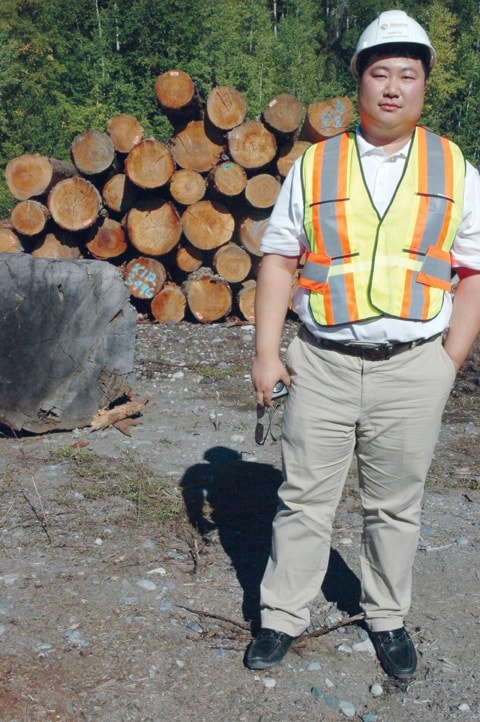A Terrace sawmill has started producing lumber for the first time since 2007.
Skeena Sawmills, which was purchased by the B.C. company Roc Holdings Ltd. in July 2011 and has spent about $6 million in BC to date including upgrades and operations, is currently testing equipment in preparation for full-capacity operations which will ramp up in the coming years.
The test stage is just one of many steps that have taken place since the mill and logging rights were purchased from West Fraser last year. And while much more is needed before the mill is running at full tilt, officials there say they’re optimistic that’s exactly what will happen. The company plans to spend up to $15 million more to get the mill running for the long-haul.
“We are doing test lumber right now to verify our operational capability,” said Skeena Sawmills’ plant manager Don MacDonald, adding this stage will determine how much of a given grade of log can be turned into finished lumber products.
Plans are to sell the highest-grade log in the raw export market, with mid-grade logs going to the sawmill to be turned into lumber products.
“There’s going to be some logs that are too valuable that we’d probably be losing money by putting a saw into it,” said MacDonald at a Terrace and District Chamber of Commerce Luncheon last week. “(But) we’re here to make lumber.”
Roc Holdings Ltd. wants to increase the mill’s processing capacity to consume up to 350,000 cubic metres of log yearly per shift with more than one shift daily being optimal. Historically the mill has consumed an average of 350,000 annually, said officials in the presentation.
The company plans to use wood from three of its cutting licences in the area — TFL 41, which is a tree farm, and two forest licences, one of which is in the Nass.
The three amount to an allowable cut of 317,000 cubic metres per year. And as about 40 per cent of that is pulp-grade wood, this means the mill will be looking to buy up to 500,000 cubic metres yearly from other log harvesters for the mill.
“We want to source more log volume,” said Skeena Sawmills’ woodlands manager Tan Calhoun. “That is a present issue we’re currently faced with.”
“There’s going to be a tremendous amount of opportunities for logging,” he said, adding the sawmill would have to pay competitive prices for logs to make it worth it for other loggers.
And in terms of selling such large amounts, while no end customers have been disclosed to date, MacDonald says there is reason to be optimistic.
Roc Holdings will sell its lumber through a Vancouver-based broker, which he said will sell all that is cut.
“Our sales and marketing will find a home for all the wood that this place is producing,” said MacDonald.
He noted that Roc Holdings has some key advantages over other B.C. lumber producers.
One advantage is that by proximity Skeena Sawmills is the closest northern mill to a B.C. port. This gives a competitive market advantage by reducing the transportation costs factored into lumber prices.
And the next advantage is a close understanding of the Chinese market.
The company itself has close ties to a major real estate, development and construction conglomerate located in China — a country that is one of the world’s largest lumber consumers with increasing demand.
The Chinese real estate giant, Shandong Riguang Group, has its head office in Rizhao, a major-port city in southeastern China.
It is owned by the parents of Teddy Cui, the owner of Roc Holdings Ltd. and Skeena Sawmills.
MacDonald said this relationship provides the mill with unique business opportunities and a deeper understanding of the Chinese marketplace.
“It gives us an advantage into the Chinese market,” said MacDonald. “How that develops is yet to be determined.”
It also helps relationships with Chinese buyers. Last week, a group of eight Chinese delegates from China National Building Materials Group Corportaion, a China-owned construction-resource materials giant, visited Terrace for a tour of the sawmill.
The company itself has 20 companies under its direct management with about 600 branches. Cui is the vice president of one of those branches. It placed 485 on Fortune’s Global 500 list in 2011, said Gian Sandhu, management consultant with Roc Holdings, adding Cui’s parents have a working relationship with the company in China.
“We hope that we’ll be able to develop a working relationship with them and that they become a customer for lumber,” said MacDonald about the mill.
But before large sales can take place, there is work to be done. The mill plans to expand its workforce by double — up from 55 workers in its initial workforce to more than 100, including local contractors.
The company’s direct employees will be members of the Steelworkers union, with which an 8-year contract has recently been negotiated.
“To run the sawmill as a full blown sawmill we’d have to add 17 jobs and then ... we’d have to add another 10. That’s per shift,” said MacDonald of jobs to be created at the mill itself. “That doesn’t include adding more staff or manager positions which we’ll need to.”
MacDonald acknowledged a shortage of skilled trades workers as a challenge, adding it is designing ways to attract workers. One method is by developing an apprenticeship program. It will also be bringing in more equipment, and upgrading some of its own.
To date, the company has spent $5 million locally on goods and services. That figure includes $561,000 in property taxes the last two years.
In a two-week period, about $400,000 was paid to local logging contractors this summer, said Calhoun.
